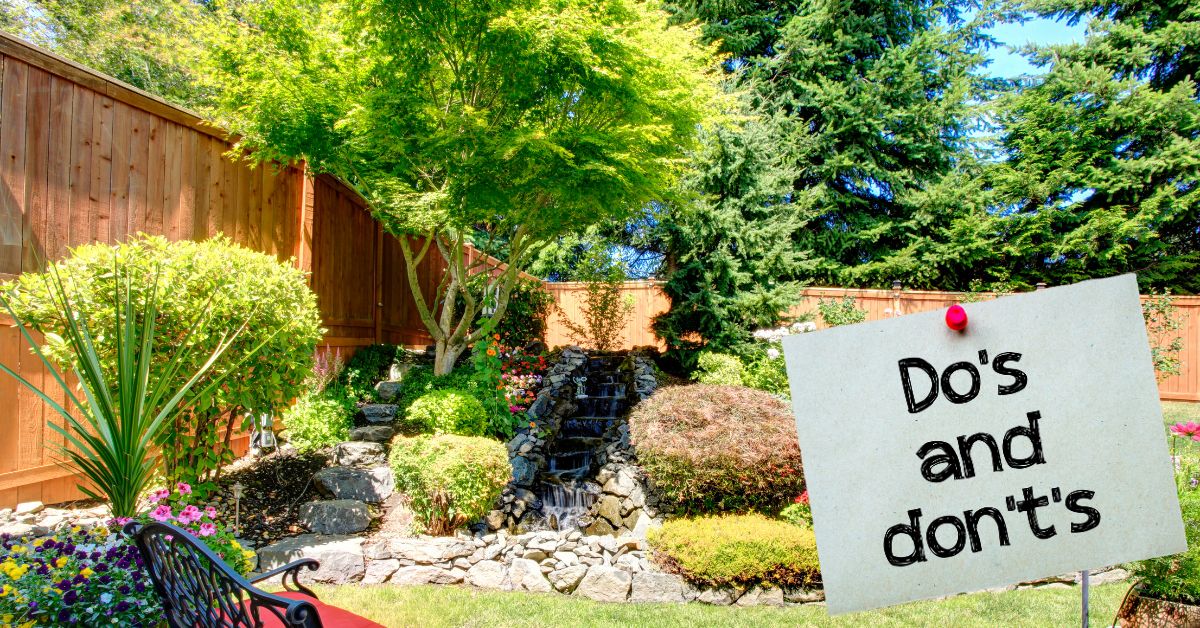Landscaping around your fence can be a great aesthetic addition to your yard to plant native flowers, provide a resource for local pollinators, or start your backyard vegetable garden. But it’s important to avoid accidentally damaging your fence with what you plant or to follow local or HOA guidelines to prevent causing a fuss with neighbors — or having to undo all your hard work!
To avoid making these mistakes, here are a few critical dos and don’ts of fence landscaping:
DO: Talk with Your Neighbors First
While you shouldn’t let your neighbors stop you from enjoying your yard, you should still let them know what you’re planning — especially if that plan includes tall trees that may hang over into their yards.
Talking to your neighbors about your landscaping plans also helps build a good relationship with them. Communicating what will be happening in your yard over the next few weeks, especially if you’ll have professionals coming in and out, is good to keep your neighbors in the loop. Additionally, you can let them know your reasoning for adding the landscaping and ensure it’s not to close your family off from the neighborhood!
DO: Review Local & HOA Guidelines
Before you make any significant updates to your home or property, it’s good practice to check with your Home Owners’ Association (HOA) or local government to ensure you can make the updates you want.
There may be certain restrictions on what you can plant or put in your yard, how tall the plants can be, and whether or not you’re allowed to have plants that hang over into your neighbors’ yards. There could also be restrictions on plants that attract certain types of animals or are considered invasive species.
In fact, the Terrestrial Plant Rule was passed in Indiana in 2020 and banned the sale of 44 non-native species of plants used for landscaping. The law aims to protect native plant species and includes plants like:
- Several varieties of honeysuckle
- Japanese Marberry
- Mugwort
- White mulberry
- Black swallow-wort
Notably, the rule does not contain the highly invasive species known as the Bradford Pear, a tree that blooms in early spring. While it’s not included in the Terrestrial Plant Rule, we don’t recommend planting this tree near a fence because they aren’t particularly strong trees and grow in a way that is susceptible to damage from strong winds and storms. Additionally, their white-pinkish flowers are notorious for their strong, unpleasant scent.
Consider planting native species around your fence to support the local ecosystem. These plants are beautiful and will attract local pollinator species like butterflies.
Your HOA may have more specific guidelines and what you can or cannot plant in your yard. This may include things like only planting specific species, restrictions on certain flower colors, or restrictions on plants growing over the height of your fence. There may also be an application and approval process to make significant changes to your yard, like adding or replacing a fence.
Failure to comply with local laws or HOA rules can result in fines and having to remove parts (or all) of your new landscaping.
DON’T Let Your Landscaping Escape Your Property Boundaries
We’ve touched on being wary of tree overhang in your neighbors’ yards, but keeping your landscaping within your property boundaries is important. For obvious reasons, your belongings should stay within the property you own.
If you’re unsure where your property lines are or if the fence is placed correctly within your property lines, you can use many apps to find your property lines. A site plan can also help show your property lines on a map. In Indianapolis, you can place a fence up to your property line, so if you wish to landscape around the outside of the fence outside, make sure the fence itself is set back from the property line first!
DON’T Use Landscaping That Can Damage Your Fence
This one also seems like a no-brainer. We already mentioned that the Bradford Pear could damage your fence or other property structures because of their low structural integrity. But there are other things to consider when placing landscaping around your fence to protect it.
Large trees and shrubs can fall and collapse the fence in a storm, but you should also consider the root systems of larger plants. Trees with large, sturdy root systems may push into fence posts over time, pushing them out of the ground or causing the fence to lean.
Be careful placing non-organic items, like stone edging or large rocks, around your fence. These materials could scratch and dent vinyl or wooden fencing when they’re placed. Decorative items like metal sculptures may also damage the fence if they fall. If the metal can rust, it may also leave rust stains on your fence, especially on lighter vinyl colors.
Be mindful of the mess when you’re planting. While there’s likely to be some soil or debris that sticks to the fence during the landscaping process, make sure to rinse it off when you’re all done. Keeping the fence clean helps keep your yard looking nice, but it also prevents buildup and keeps dirt out of the nooks and crannies of your fence that can impact its performance.
Landscaping around the fence can give your yard that je ne sais quoi you’ve been looking for, but keeping everything in check before you start will prevent fence failures and neighbor feuds. Still looking for a fence to landscape around? Chat with us about your plans, and we can help you pick a fence that’ll go with your landscaping ideas!



